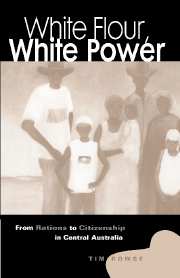Book contents
3 - Rural Central Australia, 1914–40
from PART TWO
Published online by Cambridge University Press: 23 October 2009
Summary
In 1929, Queensland's Chief Protector of Aboriginals, J.W. Bleakley, reported to the Commonwealth government on ‘The Aboriginals and Half-castes of Central Australia and North Australia’. The burden of protecting Indigenous people in Central Australia, he pointed out, rested on a small number of policemen who did not like administering medical care to Indigenous people. They also found the arrest and punishment of cattle spearers to be difficult, ‘as there were very few of the blacks who were not to some extent guilty, and wholesale arrest was impossible’. Referring to ‘the impossibility, under present conditions, of effectively patrolling the vast areas’ of the Northern Territory, he proposed not only an expanded police force but also more reserves, where missionaries could ‘provide a sanctuary for the natives, exercise a steadying influence and relieve distress’.
Enumeration of Indigenous people
Northern Territory Chief Protector C.E. Cook, the principal recipient of this advice, looked more to the police than to missionaries and reserves in seeking to improve ‘protection’. In 1930, he instructed police to enumerate the Indigenous people, district by district, in order to give some picture of the size of the Administration's responsibility. Though the results of this difficult enterprise must be read with caution, they are one way to begin describing the changing spatial and economic dimensions of inter-war contact between Central Australian people and the invaders.
- Type
- Chapter
- Information
- White Flour, White PowerFrom Rations to Citizenship in Central Australia, pp. 49 - 67Publisher: Cambridge University PressPrint publication year: 1998



